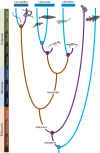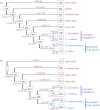Loss of olfaction in sea snakes provides new perspectives on the aquatic adaptation of amniotes
- PMID: 31506057
- PMCID: PMC6742997
- DOI: 10.1098/rspb.2019.1828
Loss of olfaction in sea snakes provides new perspectives on the aquatic adaptation of amniotes
Abstract
Marine amniotes, a polyphyletic group, provide an excellent opportunity for studying convergent evolution. Their sense of smell tends to degenerate, but this process has not been explored by comparing fully aquatic species with their amphibious relatives in an evolutionary context. Here, we sequenced the genomes of fully aquatic and amphibious sea snakes and identified repertoires of chemosensory receptor genes involved in olfaction. Snakes possess large numbers of the olfactory receptor (OR) genes and the type-2 vomeronasal receptor (V2R) genes, and expression profiling in the olfactory tissues suggests that snakes use the ORs in the main olfactory system (MOS) and the V2Rs in the vomeronasal system (VNS). The number of OR genes has decreased in sea snakes, and fully aquatic species lost MOS which is responsible for detecting airborne odours. By contrast, sea snakes including fully aquatic species retain a number of V2R genes and a well-developed VNS for smelling underwater. This study suggests that the sense of smell also degenerated in sea snakes, particularly in fully aquatic species, but their residual olfactory capability is distinct from that of other fully aquatic amniotes. Amphibious species show an intermediate status between terrestrial and fully aquatic snakes, implying their importance in understanding the process of aquatic adaptation.
Keywords: OR; TAAR; V1R; V2R; amphibious; fully aquatic.
Conflict of interest statement
We declare we have no competing interests.
Figures




Similar articles
-
Olfaction of aquatic amniotes.Cell Tissue Res. 2021 Jan;383(1):353-365. doi: 10.1007/s00441-020-03382-8. Epub 2021 Jan 6. Cell Tissue Res. 2021. PMID: 33409651 Review.
-
How Snakes Find Prey Underwater: Sea Snakes Use Visual and Chemical Cues for Foraging.Zoolog Sci. 2018 Dec 4;35(6):483-486. doi: 10.2108/zs180059. Zoolog Sci. 2018. PMID: 30520357
-
Visual adaptation of opsin genes to the aquatic environment in sea snakes.BMC Evol Biol. 2020 Nov 26;20(1):158. doi: 10.1186/s12862-020-01725-1. BMC Evol Biol. 2020. PMID: 33243140 Free PMC article.
-
Lamprey possess both V1R and V2R olfactory receptors, but only V1Rs are expressed in olfactory sensory neurons.Chem Senses. 2022 Jan 1;47:bjac007. doi: 10.1093/chemse/bjac007. Chem Senses. 2022. PMID: 35522082
-
Evolution of vertebrate olfactory systems.Brain Behav Evol. 1997;50(4):222-33. doi: 10.1159/000113336. Brain Behav Evol. 1997. PMID: 9310197 Review.
Cited by
-
Phylogeny, Ecology, and Gene Families Covariation Shaped the Olfactory Subgenome of Rodents.Genome Biol Evol. 2023 Nov 1;15(11):evad197. doi: 10.1093/gbe/evad197. Genome Biol Evol. 2023. PMID: 37972291 Free PMC article.
-
Vomeronasal Receptors Associated with Circulating Estrogen Processing Chemosensory Cues in Semi-Aquatic Mammals.Int J Mol Sci. 2023 Jun 27;24(13):10724. doi: 10.3390/ijms241310724. Int J Mol Sci. 2023. PMID: 37445898 Free PMC article.
-
Swim with the tide: Tactics to maximize prey detection by a specialist predator, the greater sea snake (Hydrophis major).PLoS One. 2020 Oct 1;15(10):e0239920. doi: 10.1371/journal.pone.0239920. eCollection 2020. PLoS One. 2020. PMID: 33002087 Free PMC article.
-
New Environment, New Invaders-Repeated Horizontal Transfer of LINEs to Sea Snakes.Genome Biol Evol. 2020 Dec 6;12(12):2370-2383. doi: 10.1093/gbe/evaa208. Genome Biol Evol. 2020. PMID: 33022046 Free PMC article.
-
Dynamic evolutionary interplay between ontogenetic skull patterning and whole-head integration.Nat Ecol Evol. 2024 Mar;8(3):536-551. doi: 10.1038/s41559-023-02295-3. Epub 2024 Jan 10. Nat Ecol Evol. 2024. PMID: 38200368
References
-
- Benton MJ. 2008. The history of life. New York, NY: Oxford University Press.
-
- Thewissen JGM, Cooper LN, George JC, Bajpai S. 2009. From land to water: the origin of whales, dolphins, and porpoises. Evol. Educ. Outreach 2, 272–288. (10.1007/s12052-009-0135-2) - DOI
-
- Heatwole H. 1999. Sea snakes. Sydney, New South Wales: University of New South Wales Press.
Publication types
MeSH terms
Associated data
LinkOut - more resources
Full Text Sources
Other Literature Sources

